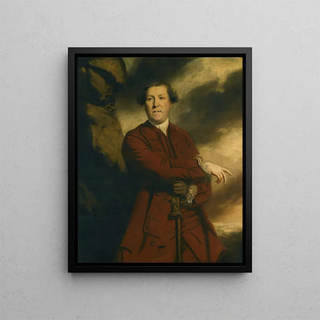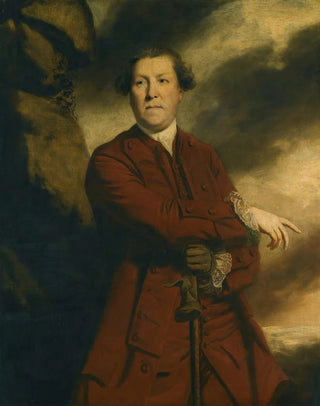Art print | Portrait of Captain Robert Haldane of Gleneagles - Sir Joshua Reynolds


View from behind

Frame (optional)
In the world of art, some works transcend time and culture, captivating viewers with their depth and storytelling ability. The "Art print of Captain Robert Haldane of Gleneagles," created by Sir Joshua Reynolds, is a perfect example. This iconic piece, painted in the 18th century, depicts a man of character, a captain whose demeanor and presence are masterfully captured by Reynolds's brush. The artwork invites attentive contemplation, revealing the subtleties of Haldane's personality while evoking the historical and social context of his era.
Style and uniqueness of the work
Reynolds's style is distinguished by his skill in blending realism and idealization. In this portrait, he manages to portray not only the physical appearance of Captain Haldane but also his essence. Light plays a crucial role in the composition, highlighting facial features and uniform details, while creating an atmosphere of dignity and nobility. The captain's slightly turned pose suggests both openness and introspection, inviting the viewer to ponder his thoughts and aspirations. Rich colors and delicate textures testify to Reynolds's technical mastery, who rendered each element—from fabric to complexion—with striking precision. This portrait is not merely a simple representation; it becomes a true visual narrative, a window into the soul of a man and the era in which he lived.
The artist and his influence
Sir Joshua Reynolds, an emblematic figure of British portraiture, left an indelible mark on art history. As the first president of the Royal Academy of Arts, he not only contributed to the rise of portraiture but also influenced generations of artists through his innovative approach and artistic philosophy. Reynolds firmly believed that art should aspire to ideal beauty while remaining rooted in reality. His work paved the way for a new way of perceiving the portrait, where the individual is celebrated in all their complexity. Through works like that of Captain Haldane,

Matte finish

View from behind

Frame (optional)
In the world of art, some works transcend time and culture, captivating viewers with their depth and storytelling ability. The "Art print of Captain Robert Haldane of Gleneagles," created by Sir Joshua Reynolds, is a perfect example. This iconic piece, painted in the 18th century, depicts a man of character, a captain whose demeanor and presence are masterfully captured by Reynolds's brush. The artwork invites attentive contemplation, revealing the subtleties of Haldane's personality while evoking the historical and social context of his era.
Style and uniqueness of the work
Reynolds's style is distinguished by his skill in blending realism and idealization. In this portrait, he manages to portray not only the physical appearance of Captain Haldane but also his essence. Light plays a crucial role in the composition, highlighting facial features and uniform details, while creating an atmosphere of dignity and nobility. The captain's slightly turned pose suggests both openness and introspection, inviting the viewer to ponder his thoughts and aspirations. Rich colors and delicate textures testify to Reynolds's technical mastery, who rendered each element—from fabric to complexion—with striking precision. This portrait is not merely a simple representation; it becomes a true visual narrative, a window into the soul of a man and the era in which he lived.
The artist and his influence
Sir Joshua Reynolds, an emblematic figure of British portraiture, left an indelible mark on art history. As the first president of the Royal Academy of Arts, he not only contributed to the rise of portraiture but also influenced generations of artists through his innovative approach and artistic philosophy. Reynolds firmly believed that art should aspire to ideal beauty while remaining rooted in reality. His work paved the way for a new way of perceiving the portrait, where the individual is celebrated in all their complexity. Through works like that of Captain Haldane,






